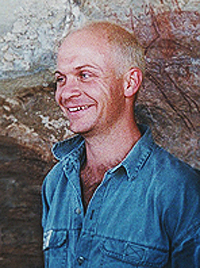 |
 |
APPENDIX 2 - TWYFELFONTEIN SITE REPORT BY SVEN OUZMAN |
| |
|
Twyfelfontein 534: Sites 1-14 / 2014 CB 1 - 14 |
Twyfelfontein 534 – also known as /Ui-//Ais (the / and # signs graphically represent certain click sounds typical of the San language - addition by M. van Hoek) – is an archaeological site complex that has very few equals in the world. Perhaps the engraved equivalent of the Brandberg, Twyfelfontein is home to well over a dozen rock art sites with over 5000 Bushman and Khoekhoen rock engravings, a few dozen Bushman rock paintings, as well as a rich associated excavation-centric archaeology. Archaeologist at Namibia’s National Museum, Goodman Gwasira, provides the following concise overview of the site:
"Twyfelfontein lies within a transitional zone between semi desert, Savannah and Mopane shrubs receiving less than 150 mm annual rainfall. Temperatures range from 10°- 28° C in winter (July) and 21° C- 35° C in summer (November). The sandstone of the Etjo formations dominates the geology of the site. The Kuiseb formationschist's capping the Damara group underlies the Etjo formation, which forms the hills bounding the valley, is predominately red and is medium to coarse-grained sandstones interbedded with several thin and discontinuous brown congromatic layers. Sandstones are typical aeolian deposits dominated by thin trough cross bedding at the top and planner cross bedding at the bottom. The sandstone layers are disjointed and as a result they are very susceptible to erosion. Fault lines develop easily along the joints; the spring (after which the site is named) being a good example of a fault line. The layers, therefore, break up into boulders giving the hill a scenic view. Twyfelfontein is known for its rock engravings and paintings and associated Late Stone Age material culture dating between 6000 and 2000 years. The site has one of the known largest concentrations of engravings in Africa executed on flat and upright slabs. Over five thousand individual figures have been recorded to date. These petroglyphs are depicted on sandstone. The diversity of depictions includes the rhinoceros, elephant, ostrich, human and animal footprints but is predominated by the giraffe. Two techniques of rock carving namely pecking and fine line were employed. The artists exploited the hue of the rock surface in the engraving technique to create a shading effect by bringing about positive and negative imprints. There are six painted rock overhangs whose motifs are dominated by human figures executed in red ochre. In contrast the paintings are executed on the walls of overhangs while engravings are on flat boulder surfaces. The occurrence of paintings and engravings in close association is very rare. The material culture excavated [by Dr. Eric Wendt] from various excavations at the sites include stone artefacts, petrified wood, ostrich eggshell beads in different stages of manufacture, fragments of ostrich eggshell containers, worked bone, mica schist pendants dating to the Late Stone Age circular stone structures, and pottery."
(Goodman Gwasira, Preliminary Report for UNESCO, June 2002).
Twyfelfontein is to be proposed to UNESCO as a World Heritage Site. The Twyfelfontein National Monument area – declared in 1952 - is currently administered by the National Monuments Council under Mr. Andjamba and run on-site by Mr. Elias Goiseb.
Dr. Ernst-Rudolf Scherz documented Twyfelfontein with extreme care in his book: Scherz, E.R. 1975. Felsbilder in Südwest-Afrika. Teil II: Die Gravierungen im Nordwesten Südwest-Afrikas. Cologne: Böhlau Verlag. In this site report I use Scherz’s alphabetical system for naming each site, beginning at the northernmost site, moving down the western side of the Twyfelfontein valley and then considering the main site complex. The Afrikaans ‘Twyfelfontein’ means ‘doubtful fountain’ while the Damara /Ui-//Ais (also Ùri-/Aus) means ‘jumping fountain’. The fountain is not, however, ‘doubtful’ but very reliable though the yield per day is small. This water source would have been one of the economic factors that attracted people to this place and enhanced its powerfully religious character. At least two macro-groups of people used this site. First were hunter-gatherer peoples ancestral to today’s Bushman or ‘San’ communities. These Bushman-like people made the majority of engravings here and these engravings are immediately recognisable by their subject matter – human figures, animals, spoor/footprint images all engraved in a pecked technique, usually quite fine. At some point around 2000 – 2500 years ago a Khoekhoen herding peoples, ancestral to today’s Damara and similar groups, moved into the area. These people had sheep and goats and also pottery. Their rock-art is very different from the Bushman imagery in that it consists almost entirely of geometric images such as circles, dots and so forth, usually made in quite a rough peck. Geometric imagery was previously though to represent ‘entoptic phenomena’ – visual hallucinations seen by trancing Bushman shamans. Though these entoptic phenomena do exist, they have a different range of geometric forms and are usually more finely done than the geometric imagery encountered at Twyfelfontein. At the very end of the descriptive site reports, I shall venture a few thoughts about the meaning of the imagery encountered here. I shall discuss the meaning of some of the Twyfelfontein imagery at the end of this site report.
→
A Survey into the Relationship between
Animal-Engravings & Cupules
→
The Rock Art of Twyfelfontein
→
The Rock Art of Namibia
→
The African Rock Art Archive
→
Bradshaw Foundation
Like us on Facebook & Follow us on Twitter to receive news & updates:





